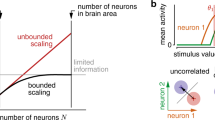Abstract.
In a previous study, we calculated the resolution obtained by a population of overlapping receptive fields, assuming a coarse coding mechanism. The results, which favor large receptive fields, are applied to the visual system of tongue-projecting salamanders. An analytical calculation gives the number of neurons necessary to determine the direction of their prey. Direction localization and distance determination are studied in neural network simulations of the orienting movement an d the tongue projection, respectively. In all cases, large receptive fields are found to be essential to yield a high sensory resolution. The results are in good agreement with anatomical, electrophysiological and behavioral data.
Similar content being viewed by others
Author information
Authors and Affiliations
Additional information
Received: 7 January 1996 / Accepted: 16 April 1997
Rights and permissions
About this article
Cite this article
Eurich, C., Schwegler, H. & Woesler, R. Coarse coding: applications to the visual system of salamanders. Biol Cybern 77, 41–47 (1997). https://doi.org/10.1007/s004220050365
Issue Date:
DOI: https://doi.org/10.1007/s004220050365




